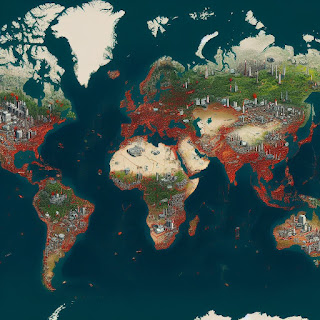Are we activists that desire to shape and influence our future, or passive spectators? Are we content to accept whatever destiny fate bestows us, or will we work to shape a particular kind of future? These questions weigh on many of us today.
In a world increasingly defined by rapid technological advances, uncertainty, and conflicting visions of the future, questions about how individuals and collective agency can be used to shape our future becomes ever more critical.
This article examines the interplay between personal and collective agency, influence, structural limitations, psychological factors, and ethical considerations, all while acknowledging the multi-layered nature of the future.
The Limits and Possibilities of Personal Agency
Personal agency allows us to make choices in career, education, relationships, time investments and lifestyles among other things. In our hyperconnected world we can also influence our networks to amplify our influence. Whether these networks are professional or personal, they act as levers that can either broaden or narrow our influence and impact. Similarly, access to various forms of capital—financial, social, or cultural—can also enhance our ability to enact change and shape our future for societal good.
Structural Constraints: The Invisible Fences
Our agency is not unlimited. We are constrained by an array of structural barriers, such as economic disparities, legal frameworks, prejudices and societal norms. These act as invisible fences, constraining our actions and influence. However, the impact of these constraints can be minimized by individual competencies like communication skills, storytelling, adaptability, online influencing expertise and leadership acumen. These skills act as multipliers of one's basic agency, converting potential into action and influence.
The Mind's Filters: Cognitive Biases
Our cognitive makeup and biases, such as optimism bias and risk aversion, can limit us. They don't merely impact how we view the future; they directly influence our willingness to engage in shaping our future. Understanding these psychological dynamics is key to harnessing or mitigating their effects.
Guiding Our Path: The Role of Ethics
Ethics are central to our future. Whether addressing immediate community concerns or pondering the global ramifications of climate change, ethical considerations must guide our actions. They elevate the dialogue from mere strategy to one of moral imperative, thus shaping our collective stewardship of the future.
A Kaleidoscopic Future: Navigating Multi-Layered Realities
The future is complex for individuals, but when you add all of the different kinds of organizations and their divergent motivations, and then the time frames they work under, it can become simply overwhelming. The future is a kaleidoscope of interacting layers. At the international level, we grapple with existential issues like climate change and global cooperation, aiming for policies with generational impact. Nations, meanwhile, focus on domestic politics and geopolitics, economic stability, and societal cohesion, often with shorter timeframes. Commercial organizations operate within these national and global frameworks, prioritizing market competitiveness and innovation, while individuals usually concentrate on immediate concerns like career and well-being.
Challenges of Alignment
The first challenge, as an activist and influencer, in aligning these layers lies in recognizing their inherent complexities and conflicts. For instance, a corporate strategy focused on short-term profitability might clash with long-term sustainability goals at an international level. Similarly, a national policy to boost economic growth might undermine efforts to combat climate change. Reconciling such divergent objectives demands deep ethical deliberation, strategic foresight, and flexible planning.
Another challenge is the different time horizons across these layers. While international or even national issues often require a long-term perspective, commercial organizations and individuals usually operate with shorter-term objectives. Bridging this temporal gap requires translating long-term goals into intermediate milestones that are meaningful at organizational and individual levels.
Becoming Influential Across Layers
1. Understanding the Terrain: To have an impact at each layer, one must first understand its specific dynamics, objectives, and limitations. This requires both broad interdisciplinary knowledge and specialized expertise.
2. Networking and Coalition-Building: One person seldom has the resources or influence to affect change at every layer. Building coalitions with like-minded individuals and organizations can amplify one’s reach.
3. Effective Communication: Tailoring your message for each layer's unique concerns and language is crucial. What resonates at an international level may be meaningless or counterproductive at an organizational or individual level.
4. Leveraging Resources: Financial, social, or cultural capital can be influential in any layer but must be applied judiciously. For example, financial resources might carry more weight at an organizational level, while social capital may be more important for influencing public opinion.
5. Strategic Adaptability: The ability to pivot, re-assess, and adapt is invaluable. Given the dynamic interplay between these layers, a rigid strategy is likely to fail.
6. Ethical Consistency: Maintaining a consistent ethical framework across all layers not only lends credibility but also aids in decision-making when interests conflict.
7. Monitoring and Feedback: It's vital to have mechanisms for gauging the impact of one's actions across layers. This helps in tweaking strategies and provides tangible proof of efficacy, which further amplifies influence.
By recognizing and understanding these complexities and interdependencies across multiple layers of the future, we can develop more effective strategies for exerting influence. We also position ourselves to align these layers better, thereby mitigating their conflicting impacts. These nuanced insights are invaluable, especially for leaders and strategists tasked with communicating intricate issues. With this multi-layered understanding, we move from being passive forecasters to active orchestrators of the future.
*I use generative AI in all my work.
***Full Disclosure: These are my personal opinions. No company is silly enough to claim them. I work with and have worked with many of the companies mentioned in my articles.









